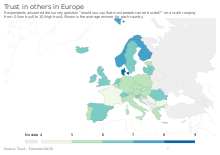اعتماد به دیگران


اعتماد به دیگران (به انگلیسی: Trust) این باور است که شخص دیگری آنچه را که انتظار میرود انجام خواهد داد. این تمایل را برای یک طرف (اعتمادکننده trustor) به همراه دارد که در برابر طرف دیگر (اعتمادشونده trustee) آسیبپذیر شود، با این فرض که اعتمادشونده به روشهایی عمل خواهد کرد که به سود اعتمادکننده باشد.[۱][۲][۳] علاوه بر این، اعتمادکننده کنترلی بر اعمال اعتمادشونده ندارد.[۱] محققان بین اعتماد گسترشیافته (که همچنین به عنوان اعتماد اجتماعی شناخته میشود)، که گسترش اعتماد به دایره نسبتاً بزرگی از دیگران ناآشنا است، و اعتماد خاص، که مشروط به یک موقعیت خاص یا یک رابطه خاص است، تمایز قائل میشوند.[۱]
منابع
- ↑ ۱٫۰ ۱٫۱ ۱٫۲ Schilke, Oliver; Reimann, Martin; Cook, Karen S. (2021). "Trust in Social Relations". Annual Review of Sociology. 47 (1): 239–259. doi:10.1146/annurev-soc-082120-082850. ISSN 0360-0572.
- ↑ Mayer, R.C.; Davis, J.H.; Schoorman, F.D. (1995). "An integrative model of organizational trust". Academy of Management Review. 20 (3): 709–734. CiteSeerX 10.1.1.457.8429. doi:10.5465/amr.1995.9508080335.
- ↑
- Lynn, Theo (2021). Data privacy and trust in cloud computing: building trust in the cloud through assurance and accountability. Palgrave Studies in Digital Business & Enabling Technologies. Cham: Springer. p. 20. doi:10.1007/978-3-030-54660-1. ISBN 978-3-030-54659-5. OCLC 1202743216. S2CID 242965934.
Trust is generally defined as a willingness to accept vulnerability based on positive expectation of another party.
- Bamberger, Walter (2010). "Interpersonal Trust – Attempt of a Definition". Technische Universität München. Archived from the original on 2011-10-09. Retrieved 2011-08-16.
- Lynn, Theo (2021). Data privacy and trust in cloud computing: building trust in the cloud through assurance and accountability. Palgrave Studies in Digital Business & Enabling Technologies. Cham: Springer. p. 20. doi:10.1007/978-3-030-54660-1. ISBN 978-3-030-54659-5. OCLC 1202743216. S2CID 242965934.